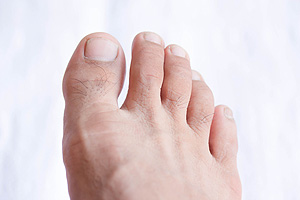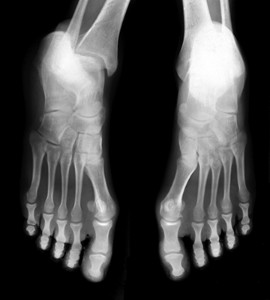 Corns, typically found on the toes, side, and bottom of the feet, can be incredibly uncomfortable and often painful. Simple everyday activities, such as walking, can become difficult if corns are left untreated. Corns are hardened layers of the skin, often caused by too much friction and the use of improper footwear. They can feel very sensitive when touched, and often become irritated when shoes are worn. To help lessen the pain of a corn, it’s advised that you wear a cushion or pad over your corn to stop any further friction. It is also suggested to soak the feet in warm water, and filing at the corn may help to decrease its size. In order to safely treat your corn, it is recommended to consult with a podiatrist for professional care.
Corns, typically found on the toes, side, and bottom of the feet, can be incredibly uncomfortable and often painful. Simple everyday activities, such as walking, can become difficult if corns are left untreated. Corns are hardened layers of the skin, often caused by too much friction and the use of improper footwear. They can feel very sensitive when touched, and often become irritated when shoes are worn. To help lessen the pain of a corn, it’s advised that you wear a cushion or pad over your corn to stop any further friction. It is also suggested to soak the feet in warm water, and filing at the corn may help to decrease its size. In order to safely treat your corn, it is recommended to consult with a podiatrist for professional care.
Corns can make walking very painful and should be treated immediately. If you have questions regarding your feet and ankles, contact one of our podiatrists of Westside Podiatry Center, LLP. Our doctors will treat your foot and ankle needs.
Corns: What Are They? And How Do You Get Rid of Them?
Corns are thickened areas on the skin that can become painful. They are caused by excessive pressure and friction on the skin. Corns press into the deeper layers of the skin and are usually round in shape.
Ways to Prevent Corns
There are many ways to get rid of painful corns such as:
- Wearing properly fitting shoes that have been measured by a professional
- Wearing shoes that are not sharply pointed or have high heels
- Wearing only shoes that offer support
Treating Corns
Although most corns slowly disappear when the friction or pressure stops, this isn’t always the case. Consult with your podiatrist to determine the best treatment option for your case of corns.
If you have any questions please feel free to contact one of our offices located in Liverpool, Camillus, Skaneateles, Oswego, and Cicero, NY . We offer the newest diagnostic and treatment technologies for all your foot and ankle needs.









